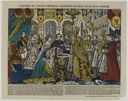María
Eugenia Ignacia Augustina de Palafox Portocarrero de Guzmán y Kirkpatrick,
Empress Eugénie, is one of history's tragic beauties, joining Empresses
Elisabeth of Austria and Carlota of Mexico. She was beautiful and married Emperor Napoleon III - what would sound
like a girl's happily-ever-after dreams come true. But the Emperor was
unfaithful, apparently flagrantly so, leaving her just one child, a son. Her
son did what royal sons did and still do, served in the military, but in the
British Army. When the Zulu contested British ambitions in South Africa, the
Prince Imperial served there and died during the Zulu Wars - leaving her with
no grandchildren.
I
have read that she wasn't really that interested in clothes. But she dressed
like a true Empress and she was elegant and endowed with wonderful taste. While
royal wives often played second fiddle to mistresses in fashion (such as Louise de la Valliere, the Marquise de Montespan, and the Marquise de Pompadour), Napoleon III's numerous
mistresses took back seat to the Empress Eugénie. One objective of
her dressing was to provide work for people in the luxury goods businesses. Her
beauty and elegance doubtless also made for great propaganda and she was a
wonderful trophy wife. A number of artists painted portraits of her shown in
this subalbum. Her Wikipedia
article mentions her contributions to fashion. One thing Empress
Eugénie did not do is invent the cage crinoline, but she did like it and helped
to popularize it.
She
knew Princess Pauline
Metternich, wife of the Austrian ambassador who self-deprecatingly
referred to her simian features, who discovered the fashion hose run by Charles
Frederick Worth, a British emigre. Princess Metternich is covered later in this subalbum. Princess Metternich brought Worth
to the Empress' attention, ensuring Worth an unequalled role in fashion
history. Worth created haute couture
as it was known until recently with exclusive designers making custom-fitted
clothes for exclusive clients. Designers operated from posh shops and displayed
their creations on living manequins. The elite wore designer dresses that
everybody copied. Now fashion does not flow down from designers to elite to
everyone else. Fashion often flows up "from the streets." Stores watch
sales to spot emerging trends so the style can be manufactured and rapidly
stocked using just-in-time management, production, and shipping techniques with
electronic assistance.
Eugénie
was born to a Spanish aristocratic family where she grew up with one sister who
had better matrimonial luck, María Francisca. María, also covered in this
subalbum, married the Duke of Alba. Eugenie's mother was a
larger-than-life figure, María Manuela Enriqueta Kirkpatrick de Closbourn
y de Grevigné, Countess of Montijo, the subject of this Wikipedia
article.
Reunion
des Musées Nationaux has 40 pages,
each with nine images of Eugeniana. Some of those images are used here.
This album will become a
subalbum in an album about early Victorian dress (1837-1870).




































































![1857 Eugénie, Empress of the French (1826-1920), née Countess of Montijo de Teba de Guzman in a wide-brimmed hat by Franz Winterhalter [Hillwood Mueum (?)]](../_Media/empress_eugene_private_cole.jpeg)














































































































